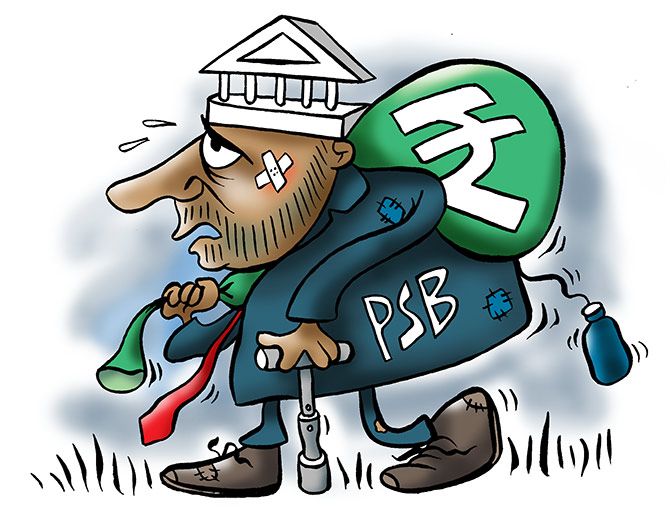 | « Back to article | Print this article |
PSBs’ gross NPA ratio may decline to 12 per cent by March 2019 in the baseline scenario, whereas private banks’ gross NPA ratio may decline from 3.7 per cent to 3.2 per cent in March 2019.
Illustration: Uttam Ghosh/Rediff.com

The quality of assets in the banking sector may improve in 2020, show stress tests conducted by the Reserve Bank of India (RBI).
In a baseline scenario, the gross non-performing assets (NPA) ratio of all scheduled commercial banks may come down from 9.3 per cent in December 2019 to 9 per cent by March 2019, said the RBI’s Financial Stability Report (FSR), released on Thursday.
The asset quality of public sector banks (PSBs), which have the highest concentration of NPAs, may improve from 12.6 per cent in March 2019.
PSBs’ gross NPA ratio may decline to 12 per cent by March 2019 in the baseline scenario, whereas private banks’ gross NPA ratio may decline from 3.7 per cent to 3.2 per cent in March 2019.
The gross NPA ratio of foreign banks in the baseline scenario might also decline from 3 per cent to 2.9 per cent in March 2019.
“The increased pace at which NPAs was recognised led to the NPA cycle peaking in March 2018.
"With most of the NPAs already recognised, the NPA cycle turned around, with gross NPA ratio declining to 9.3 per cent in March 2019.
"There was convergence of stressed advances ratio, with gross NPA ratio across all bank groups.
"The year-on-year growth in gross NPAs also decelerated across all bank groups,” said the central bank.
In an assumed baseline macro scenario, system-level capital adequacy ratio (CAR) is projected to come down to 12.9 per cent in March 2020, from 14 per cent in March 2019.
Further deterioration of CAR to 11.6 per cent is projected under severe stress scenario, according to the RBI.
A stress-hit of this magnitude will mean 21 banks, with a share of 58.6 per cent of the banking systems’ total assets, might fail to maintain the required CAR.
PSBs were found to be severely impacted, with the CAR of 19 of the 21 PSBs likely to go down below 9 per cent in case of such a shock, said the RBI.
Stress test on bank’s concentration risk showed that if top three individual borrowers - according to their stressed advances - fail to meet their revised payment commitments, the impact was significant for eight banks, which account for 14.6 per cent of the total assets of banks.
The same scenario with top three individual borrowers - according to their exposure - could severely impact seven banks.
Stress tests on group borrowers reveal that as many as eight banks will not be able to maintain their CAR level at 9 per cent, if top three group borrowers fail to meet their payment commitments, said the RBI’s report.
The losses could be around 6.4 per cent and 12.1 per cent of the capital at the system level in the assumed scenarios of default by the top group borrower and by the top two group borrowers, respectively.
A sector-wise stress test revealed that telecom will register the highest growth in NPA, followed by the metals sector, said the RBI’s stress test.